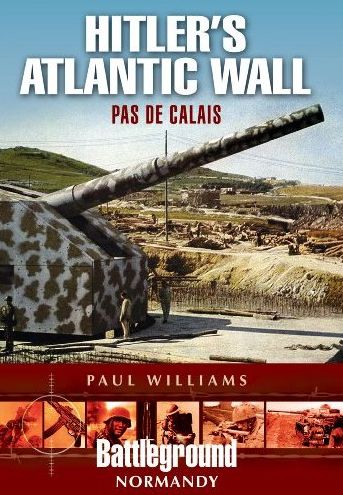| Title: | Hitler's Atlantic Wall |
| Author: | Paul Williams |
| Editor: | Pen & Sword Books |
| Published: | 2013 |
| ISBN: | 184884817-X |
| Pages: | 176 |
| Review: |
Between the summer of 1940 and D-Day along the coast of western Europe over ten thousand bunkers and defense installations were constructed by the German occupational forces. Over 1,4 million laborers built the 2600 kilometers long defense line which had to protect against an allied invasion. The Atlantic Wall did not succeed but almost seventy years after the allied invasion along this coast numerous defense installations have been saved. These are the witnesses of a huge construction project as part of the German defense of Europe. Next to that these are popular objects for tourism. Yearly they come in large numbers to mainly Normandy and the coast of the Dover Strait to inspect and photograph the remains of the Atlantic Wall. Here some of the largest buildings can be found. Therefore the concise ‘Battleground Series’ of the British publishers Pen & Sword recently has been expanded with an issue about the bunkers of Hitler’s Atlantic Wall on the main land coast of the Pas de Calais. Author Paul Williams is a British journalist. He also works as a free-lance author for magazines and web sites involved in history. He did not specialize so far in a specific subject in history, until he wrote the book ‘Malta, Island under siege’ in 2009. This book was also published in the Battleground Series. That series comprises over one hundred books about mainly the First and Second World War. The Battleground issues are always built up with double purpose. On the one side each issue is an informative book which provides the reader with more information about the subject. On the other hand it is at the same time a guide for a visit to the battle ground in which all kinds of places worth seeing can be found and with which the reader can plan his own battle field tour at the hand of various geographical maps and travel recommendations. In that respect this latest issue is not an exception in this series. Already in the introduction it is explained to the reader how to get to the former battle field. Thereafter the following six chapters concern the previous history, the reason for construction of the Atlantic Wall, the constructing itself and the efforts of the allies to break through these defenses. Especially the chapter about the construction of the Atlantikwall has been concisely illustrated with many photos and floor plans of the various bunkers and case mates. It provides the reader with a good insight in how the defenses were supposed to operate. This is again a nice addition for those who want to use the book for a trip to the former battle field. The last chapter can be used as a tour guide in which the various places of interest are being described and a round trip can be planned. With it's 176 pages ‘Hitler’s Atlantic Wall’ however is not a too detailed book. Together with a list with which abbreviations and names are being explained, it makes this book an excellent read for those who want to prepare for a trip to the main land coast of the Pas de Calais. For those who want dig deeply into the German defenses of the west coast of Hitler’s Third Reich this book will be a bit shallow. The book does not provide much information which cannot also be found elsewhere. Therefore the book will be mainly appealing to a certain limited category of readers. Paul Williams has succeeded to write in the familiar way of the publications of the Battleground Series. With this richly illustrated issue in hand one can make a well informed trip along the remains of the part of the Atlantic Wall along the Dover Strait. The concise description is easy to understand for the less informed reader. People looking for an in depth description of the German defenses along the coast of western Europe will have to expand their search however. ‘Hitler’s Atlantic Wall’ is better suited to be used as a battle field guide. |
| Rating: |
|
Information
- Translated by:
- Fred Bolle
- Article by:
- Pieter Schlebaum
- Published on:
- 05-04-2013
- Feedback?
- Send it!




